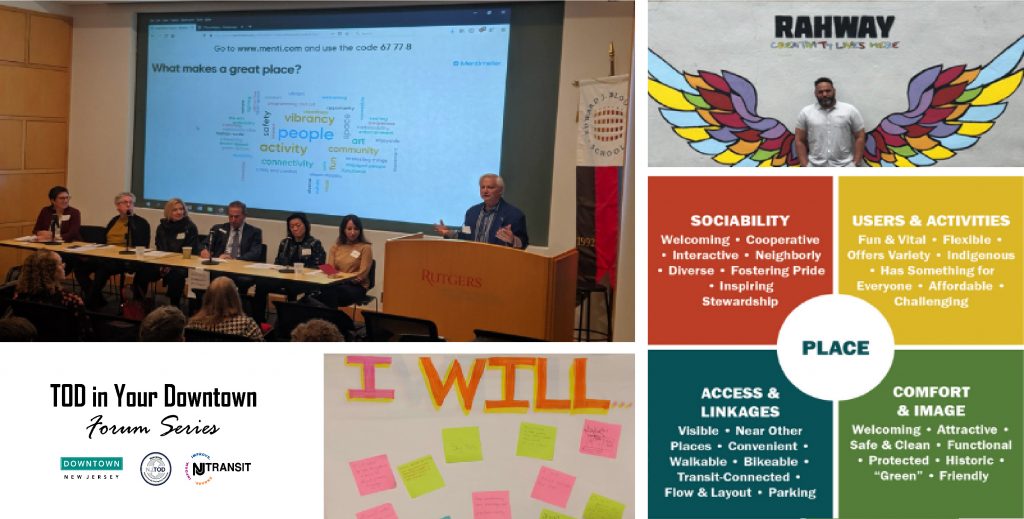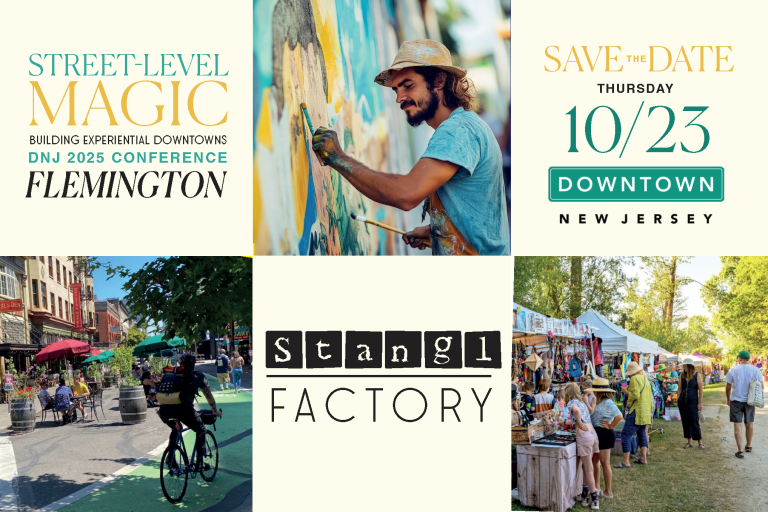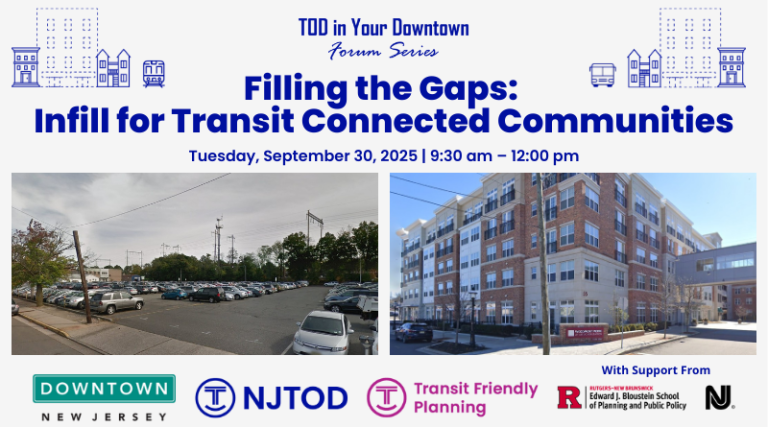TOD in Your Downtown Forum: Placemaking in Transit-Friendly Downtowns
Stephanie DiPetrillo
Principal Investigator & Editor, NJTOD.org
Justine Angela Recio
Graduate Research Assistant, Bloustein School of Planning & Public Policy
February 11, 2020
(The following article is reprinted with permission of NJTOD.org.)

Stuart Koperweis and our panel of placemaking experts discussed what makes a great place.
Planners, municipal officials, members of the real estate community, and placemaking experts gathered on December 6, 2019 at the Edward J. Bloustein School in New Brunswick for the 2nd TOD in Your Downtown Forum. Organized by Downtown New Jersey, NJTOD.org, and NJ TRANSIT, Creating Places for People: Placemaking in Transit-Friendly Downtowns, brought together experts and practitioners to discuss the how-tos of placemaking, the outcomes and impacts of implementing placemaking strategies, and the question, “What makes a great place?”
Six panelists, representing a wide range of organizations, explored how the placemaking process strengthens connections between people and the places they share, fostering a sense of belonging, community, and pride. Speakers included Christine Blanco (Manager of Facilities Signage and Transit Arts, NJ TRANSIT), Lilian Cho (Project Lead, Urban Essex Coalition for Smart Growth), Paul Silverman (Principal and Co-founder of SILVERMAN, a real estate development firm based in Jersey City, NJ), Amy Garcia Philipps (Executive Director, Rahway Arts + Business Partnership), Robb Sewell (Public Relations Specialist, educator, and author working in Collingswood, NJ), and Laura Torchio (Deputy Director of Transportation, Project for Public Spaces). The conversation was moderated by Stuart Koperweis of Economic Development Strategists, LLC.

Adapted from presentation by Laura Torchio, Project for Public Spaces.
What makes a Great Place?
Laura Torchio kicked off the forum with an audience poll asking “what do social spaces need in order to be great?” Responses centered on activity, people, vibrancy, and features that make spaces easy-to-use. Results captured how sufficient transit options and parking are vital to making community spaces and placemaking events successful by making these spaces accessible to a wide variety of people.
Place Matters: Placemaking is in the Best Interest of All
The panelists agreed that without conscious placemaking, neighborhoods can turn into inhospitable, disconnected spaces and that projects that create comfortable and vibrant social spaces serve the interests of the local community. The speakers shared examples from their own work including revitalizing railway stations with art, establishing community gardens, and creating community events such as farmer’s markets, art, and music festivals. As local community life thrives, downtowns attract more businesses, introduce restaurants, cafes, and retail spaces, and bring healthier food options to residents. These walkable spaces encourage more physical activity and social engagements.
Learning from the Experts
Panelists engaged in a round table discussion fed by questions from the moderator.
What advice do you have for those working on placemaking in their community?
Involve everyone. Everyone, including government officials, artists, business owners, residents, planners, and developers, needs to be in the room to help plan according to moderator Stuart Koperweis. Small-scale public and private partnerships and supportive city governments can be instrumental in placemaking projects successful.
Start small and grow. Planning community events and starting placemaking projects can be a long and bureaucratic process. Pop-up events are a good way to generate interest and support for the project and can win over nay-sayers. Amy Garcia Phillips described an effort in Rahway that began with a single table and chairs placed between two buildings and grew into “The Paseo,” a community space that also serves as a stage for local musicians.
It’s just temporary (but it doesn’t have to be). New businesses can contribute to place and, moreover can benefit from starting small. Last fall, when Jersey City-based developer Paul Silverman partnered with brothers Vinny and Cosmo Cangiano, the only viable space for their sandwich shop was a 4-foot by 6-foot storefront. Now known as Cangiano’s Fine Foods and Deli Pop-Up Shop, the business has established itself in the neighborhood and will be moving into larger quarters across the street in early 2020.

The Rahway Paseo. Photos courtesy of Amy Garcia Phillips | Rahway Arts + Business Partnership.
What are the first steps towards placemaking events?

Cangiano’s Fine Foods and Deli Pop-Up Shop. Courtesy of SILVERMAN.
Identify needs. Collingswood’s Rob Sewell suggests beginning by asking where are the voids? What are the needs to be filled first? Have you ever thought that your community could really use [fill in the blank]? Guess what? That’s where you start.
Give the community ownership. Laura Torchio of Project for Public Spaces suggests first hosting a community potluck or other engagement-focused event to ask the community what they want and to find local champions to lead the project.
Don’t do it alone. Set up a committee or team to plan events! Utilize the collective talent of your community. Ask partners for input and resources. Start by asking folks when to hold the event or kick off the project.
How can we incorporate social equity in placemaking?

One of Collingswood’s placemaking groups, Porchfest, brings musicians to the front porches in the borough’s downtown.
Reach out to the community (-ies). Not every event, activity or art installation needs to appeal to everyone, but the needs of everyone in the community must be addressed through placemaking. Think about the needs of the youngest and the oldest members of your community. Draw upon the art, culture, food, experiences, and expertise of all of your residents. Rob Sewell discussed how the LGBTQ+ community has played an active role in advancing placemaking and how “communities of circumstance” such as cancer survivors, pet lovers, book lovers, etc. have contributed to activities in Collingswood.
How do we utilize our transit-friendly downtowns for placemaking?
It’s a [fill in the blank]. Amy Garcia Phillips shared all the many ways that Rahway has used its station plaza… a meeting place, a stage, a yoga studio, a dance hall, a farmers’ market, an art gallery, a place for story time… the sky’s the limit!

The many uses of the Plaza at Rahway Station. Stage, dance hall, art gallery, story time, farmers market, yoga (Clockwise from upper left).
It’s also a sign. In addition to serving as gathering places, transit stations see lots of foot traffic and can be used to communicate information about ongoing projects to those who pass through each day. According to Amy Garcia Phillips, this strategy can be more effective than traditional means of communication such as newsletters.
Art + Infrastructure. Placemaking is an opportunity to look at deeper issues in downtowns and in transit hubs. Though many projects focus on art installation, Lillian Cho suggests first identifying infrastructure that needs attention and connecting those needs with art to improve the physical environment at transit stations.
Stations as places. Christine Blanco of NJ TRANSIT’s Transit Art program reminded the audience that the station or stop can be an essential part of the making of a place. For example, artists and community members can work together to produce art that captures the beauty and history of a community and make this art part of the transit center.

NJ TRANSIT Arts. Glazing work by J. Kenneth Leap. Pennsauken Rail Station (left) and Lindenwold Rail Station (right).
We Are All Placemakers

Inspired and invigorated by the discussion, the panel charged participants to think about how they might use the ideas shared to jumpstart placemaking in their own communities. Participants were asked to commit to taking action and to think about their next step as “I will….” From brainstorming ideas to locating resources, from engaging with less heard from groups to saying “yes” to requests, each participant considered, and committed to, taking the next step toward transforming spaces into places in their communities.
Need some help to get started?
Check out these placemaking resources to advance work in your TRANSIT-FRIENDLY DOWNTOWN.
Collingswood, NJ
Collingswood Book Festival
Porchfest Collingswood
Reflections of Cancer Calendar (2019)
Economic Development Strategists, LLC
NJTOD.org
Creating Public Spaces for Transit-Oriented Communities
Four Communities Share Key Lessons Learned from Creative Placemaking on Vacant Properties
Transformation Strategies Yield Results for Downtown Metuchen
NJ TRANSIT. Transit Arts
Project for Public Spaces
A Playbook for Inclusive Placemaking
Streets as Places Toolkit
The Case for Healthy Places
Rahway Arts + Businesses Partnership
SILVERMAN: Building Communities
Urban Essex Coalition for Smart Growth
Urban Essex Coalition for Smart Growth: NEXT STOP ART



